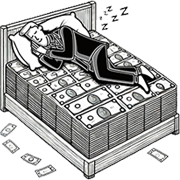HUMOR IN MARKETING SCORECARD
from the book Alien Robot Banker
START ELEVATING YOUR MARKETING WITH HUMOR
Below, you’ll find the Humor in Marketing SCORECARD, number three of the three main resources from the book.
- Humor in Marketing SCORECARD

Mr. Coin, The Banker: Helps you decipher what’s working so you sleep worry free
Use this scorecard to measure the effectiveness of your humorous marketing campaigns and optimize for long-term success.
1. Engagement Metrics
What to Track:
- Social Media:
- Likes
- Shares
- Comments
- Views
- Video Performance:
- Total views
- Average watch time
- Completion rate
Why It Matters:
High engagement suggests that the humor resonates with your audience. Use these metrics to gauge interest and virality.
2. Conversion Rates
What to Track:
- Sales & Leads: Track any increase in sales or leads during and after the campaign.
- Click-Through Rates (CTR): Monitor how effectively your Call to Actions (CTAs) drive traffic.
Why It Matters:
Conversion rates indicate whether your humor translates into tangible actions like purchases or sign-ups.
3. Brand Awareness & Recall
What to Track:
- Surveys & Polls: Conduct pre- and post-campaign surveys to measure brand recall.
- Brand Mentions: Use tools to track increases in mentions across social media, forums, and blogs.
Why It Matters:
Stronger brand recall and awareness show that your campaign leaves a lasting impression.
4. Website Analytics
What to Track:
- Traffic: Measure increases in visitors to your website during the campaign.
- Behavior Flow:
- Time spent on site
- Bounce rates
Why It Matters:
Website metrics reveal how your humorous ads drive curiosity and sustain audience interest.
5. Customer Feedback
What to Track:
- Reviews & Testimonials: Collect feedback related to the campaign’s humor.
- Focus Groups: Test audience reactions to refine future campaigns.
Why It Matters:
Direct feedback uncovers the strengths and weaknesses of your humor, providing actionable insights.
6. Competitive Analysis
What to Track:
- Benchmarking: Compare your campaign metrics with competitors.
- Market Share: Monitor changes in market share tied to your campaign timeline.
Why It Matters:
Understanding your competitive standing highlights the success of your humor strategy in the broader market.
7. Sentiment Analysis
What to Track:
- Social Listening Tools: Use platforms like Brandwatch or Hootsuite to monitor the tone of conversations around your brand.
- Content Analysis: Review comments and feedback for positive and humorous responses.
Why It Matters:
Positive sentiment reinforces the effectiveness of humor in enhancing your brand’s image.
8. Ad Performance Metrics
What to Track:
- Cost Per Click (CPC)
- Cost Per Acquisition (CPA)
- Return on Investment (ROI)
Why It Matters:
Lower CPC and CPA, paired with higher ROI, demonstrate a cost-effective and impactful campaign.
Example Process for Application:
- Launch Campaign: Deploy the humorous campaign across social media, email, and video platforms.
- Track Engagement: Use analytics tools to monitor likes, shares, comments, and views.
- Monitor Website Traffic: Identify spikes in site visits and track behavior flow.
- Collect Feedback: Conduct surveys, focus groups, and collect reviews to analyze campaign impact.
- Analyze Sales Data: Measure pre-, during-, and post-campaign sales performance.
- Refine: Use insights to tweak humor strategies and improve future campaigns.
Key Takeaway:
Metrics are your compass, but relationships are your ultimate goal. Focus on building lasting connections with your audience while using this scorecard to refine and optimize your humor-driven campaigns. When done right, humor not only entertains but also converts and retains loyal customers.
